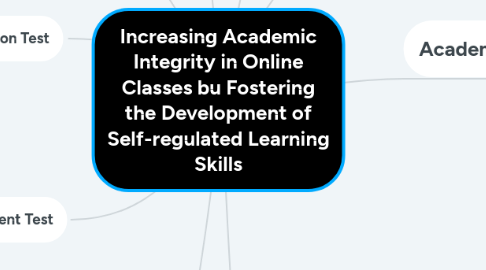
1. Adaptability Test
1.1. Graduate students
1.1.1. Forethought through daily course interaction
1.1.2. Printing relevant material
1.1.3. Self-monitoring
1.1.4. Self-reflection using discussion posts
1.1.5. Record keeping by locating sufficient computer resources and frequent backups
1.2. Undergraduate students
1.2.1. Note-taking
1.2.2. Online calendar
1.2.3. Adjusting daily routine
1.2.4. Monitoring online grade book
1.2.5. Motivated by instructor’s virtual presence
2. Engagement Test
2.1. Undergraduate students
2.1.1. Online course
2.1.1.1. More involved in class discussions
2.1.1.2. More engagement w/ the course
2.1.2. Lecture class
2.1.2.1. More collaborative in their learning w/ classmates
3. Self Regulation Test
3.1. Graduate students
3.1.1. Higher levels of critical thinking and lower levels of procrastination
3.2. Undergraduate students
3.2.1. Greater task value beliefs and greater intentions to enroll in future online courses
4. Anxiety Test (Significant amount of value)
4.1. Female students
4.1.1. Self-efficacy for learning and development
4.2. Male students
4.2.1. Task value
4.3. No difference between motivational beliefs, academic achievement, self-regulated learning
5. Self-Regulated Learning (Online)
5.1. Skills to set goals and manage learning
5.1.1. Transform mental abilities into academic performance
5.2. Proactive process
5.2.1. Acquire academic skills through
5.2.1.1. Task definition
5.2.1.2. Goal setting
5.2.1.3. Planning and implementation of strategies to reach goals
5.3. Self-evaluation and monitoring
5.3.1. Track one’s progress and effectiveness
6. Course Design Strategies and Reccomendations
6.1. 1. Use extensive calendaring
6.1.1. Consistent weekly deadline to avoid confusion
6.1.1.1. Reduces pressure and academic dishonesty
6.1.1.2. Promotes task planning, goal setting and time management
6.2. 2. Decrease exam weight
6.2.1. Reduce grade pressure by using many exams, each with a low contribution
6.2.2. Minimize the use of online exams to reduce opportunities for cheating
6.3. 3. Randomize exam questions
6.3.1. Vary the type of assessment tool throughout the semestrer
6.3.2. Assist peers instead of providing a response
6.4. 4. Discuss academic integrity/ plagiarism
6.4.1. Explain how to summarize sources and use more specialized academic databases (Not Google or Wikipedia)
6.4.2. Create awareness and common understanding
6.4.2.1. Honor Code
6.4.2.2. Authenticity statements
6.4.2.3. Enforce sanctions
6.4.2.4. Define academic dishonesty
6.5. 5. Allow asynchronous learning
6.5.1. Accommodates different schedules and learning abilities
6.5.2. To decouple student progress in the class
6.6. 6. Track student submissions
6.6.1. Spreadsheet table of the day and time of all homework submissions
6.6.2. Column sort identifies potencial inconsistencies
6.7. 7. Provide prompt feedback
6.7.1. Return graded material within 2 days to assist students w/ self-monitoring their progress
7. Disadvantages
7.1. Reduced teacher interaction
7.1.1. They may ignore differences in student’s development
7.2. Limited instructional support
7.3. Apprehension and Anxiety
7.3.1. Students w/ no cognitive or psychosocial skills yet developed
7.3.1.1. Not Self-regulated Learning
8. Distance Learning
8.1. Promising and viable alternative to traditional learning
8.1.1. Students are not bound by geographical barriers
8.1.2. Saves time and transportation costs
8.1.3. Flexible schedule
8.1.4. Schools are able to better utilize limited resources
8.1.4.1. Reduce employment costs
8.1.4.1.1. Increase student access
8.2. Broadcasted in real time
8.3. Asynchronous learning
8.3.1. Nuevo Tema
8.4. For adults, students w/ special needs, average students
8.4.1. High-speed Internet access and instructional technology
8.4.1.1. Web-based courses
8.4.1.2. Virtual public schools
9. Academic Dishonesty
9.1. Plagiarism
9.2. Cheating in online exams
9.3. Proliferation of technology
9.3.1. Use more Internet than books
9.3.2. New forms of academic dishonesty
9.4. New online Learners
9.4.1. Apprehensive to manage technical, organizational and social challenges
